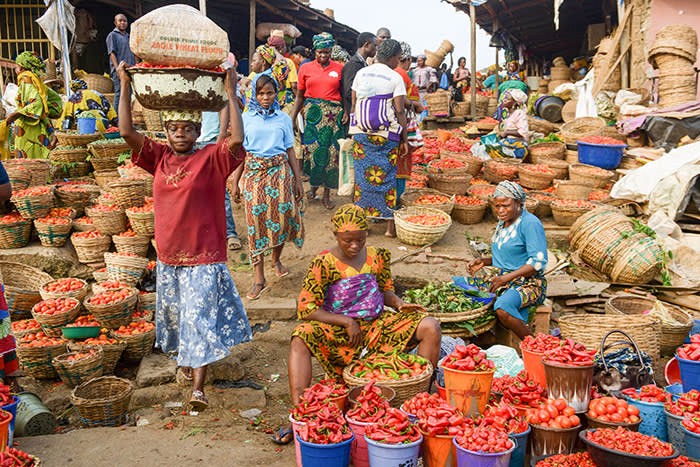
A Nigerian food market... Photo: File
The prices of foodstuffs used in preparing jollof rice increased by 9.7 percent between September 20222 and March 2023.
This is contained in SB Morgen’s latest report, titled, ‘The SBM Jollof Index: Remaining Within a Vicious Cycle’.
The index covers major food items used in making a pot of jollof rice such as rice, curry, thyme, seasoning, groundnut/vegetable oil, turkey/chicken, beef, pepper, tomatoes, salt and onions.
According to the report, poor climate conditions, insecurities, and poor policies are some of the reasons for the increase in prices of foodstuffs in Nigeria.
“Nigeria is facing a persistent food insecurity crisis that is continually aggravated by insecurity, poor policies, adverse weather conditions, and international events such as the recent Russia-Ukraine war.
“This alarming situation stems from various factors, including unstable food-producing regions, inadequate storage infrastructure, and a lack of agricultural commercialisation.
“Policies ostensibly aimed at reducing food imports over the past years still have a lingering effect, and increased energy tariffs have further exacerbated the problem. An ill-fated currency exchange attempt worsened what was already a bad situation,” the report reads.
The SBM report shows the national average cost of making a pot of jollof rice across the 13 markets in the six geopolitical zones of Nigeria.
According to the data, over seven months (September 2022 to March 2023), the cost of preparing a pot of jollof rice has risen from N9,917 to N10,882, marking an increase of 9.73 percent.
“From September 2022 to March 2023, the cost of making a pot of jollof rice increased in every market. Port Harcourt experienced the highest percentage increase at 22.7 percent, followed by Calabar Municipal at 14.7 percent, Bayside Mbakpa at 13.7 percent, and Kano at 13.3 percent,” SBM said.
On the month-to-month examination, the research firm explained that the costs of foodstuffs generally increased from September to January.
“The most substantial spike occurred in November, with a 6.6 percent increase. Between September and October, the index saw a more modest growth of 1.81 percent, while January experienced a 0.88 percent increase.
“This upward trend shows that the prices of essential ingredients for jollof rice have increased. The period between September and November saw long petrol queues across the country, which led to supply chain disruptions and inadequate supplies of food ingredients.
“As the fuel scarcity failed to ease, the prices of items like rice and chicken increased in November as preparations for the end-of-year festivities began, which are often,” the agency added.
This year, SBM expanded its report to include two cities — Accra and Kumasi — in Ghana, West Africa’s second-largest economy, as part of a broader regional edition.
The organisation said the jollof index now aims to provide a clearer understanding of “food inflation across West Africa and provide a basis of comparison that ordinary people and sophisticated observers alike can quickly intuitively use across multiple countries”.
To make the comparison between Nigeria and Ghana clearer, the report analyses the data in naira and cedis when comparing both countries but converts to US dollars at three rates: Ghana’s exchange rate and the two rates in Nigeria — official and parallel.
“From the data, it can be observed that the price of Nigerian jollof has been increasing over time, with fluctuations. The price started at $13.42 in July 2016 and increased to $24.23 in March 2023.
“In the only three months for which Ghanaian jollof data is available (January to March 2023), the price started at $23.94 and increased to $24.14.
“When comparing the Nigerian and Ghanaian jollof prices in these three months, Nigerian jollof is slightly more expensive than Ghanaian jollof, but using the official Nigerian exchange rate, a country-by-country price list of a popular fast-food chain, Chicken Republic, with branches in both Ghana and Nigeria shows that the price of Ghanaian jollof is higher,” the report said.
SBM, therefore, urged government and stakeholders to address the issues with price fluctuations and ensure food security for Nigerian citizens.
The research organisation added that there will be a need to focus on improving agricultural productivity, addressing supply chain inefficiencies, and implementing measures to curb inflation.











